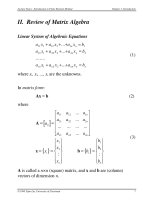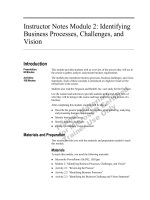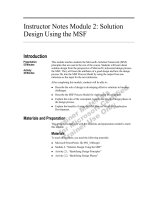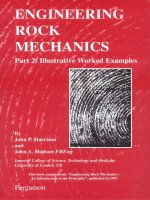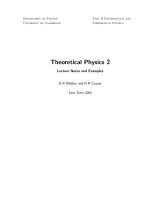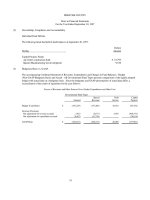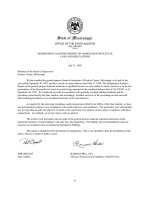2 column rock notes
Bạn đang xem bản rút gọn của tài liệu. Xem và tải ngay bản đầy đủ của tài liệu tại đây (755.65 KB, 36 trang )
Minerals & Rock Unit
Notes
th
7 Grade Science
Rocks
•Are divided into 3
groups based on
how they were
formed
•Sedimentary
•Metamorphic
•Igneous
•Are made of one or
more minerals
• Do not stay the same
• Continually changed
by processes such as
Weathering, Erosion
Compaction,
Cementation, Melting,
and Cooling.
• Rocks can change
to and from the 3
types
The Rock
Cycle
EARTH MATERIALS
CHANGE BACK AND
FORTH AMONG THE
DIFFERENT TYPES OF
ROCKS.
We
Co athe
mp rin
act g,
ion Ero
, C sio
em n, D
en
tat epos
ion itio
n
Igneous
(Granite
#11)
Melting, Solidification
Recrystallization
Melting,
Solidification
Recrystallizat
ion
Metamor
Weathering, Erosion,
(Sandstone #6)
Deposition, Compaction,phic
Sedimentary
Cementation
(Gneiss #14)
Processes
that form
Sedimenta
ry Rock
• Weathering: the breaking
down of the Earth’s material
by natural processes
(Water, Wind, Ice,
Chemicals, etc.) into smaller
pieces or sediments
• Erosion: weathered rock and
soil particles are moved
from place to place
• Deposition: weathered
sediments are laid down in a
new location creating new
landforms or rocks
• Compaction: heavy
sediments press down on
Processes
that form • Melting: caused by heat
and pressure around the
Igneous &
rock to form magma
Metamorphi • Solidification: magma
c Rock
cools and hardens
• Recrystallization: while
cooling, rock can develop
crystals, depending on
conditions
Complete the
following:
•Turn in your Rock Cycle
Directed Reading &
Earthquake/Volcano Test
Corrections
•Get the 2 Directed Readings
from the table
•Have something to write with
Complete the
following:
•Turn in your Rock Cycle
Directed Reading, Comic
Strip & Earthquake/Volcano
Test Corrections
•Get the Igneous Rock
Directed Reading from the
table
•
Igneo
us
• Igneous is Latin for
“born of fire”
• Formed from
cooling magma or
lava
• Forms when
magma cools
and solidifies
• Some reaches
the surface of
earth before
cooling, other
Intrusive
(Example:
Granite)
• Form below ground
from magma
• Usually has coarse
crystals (grains) from
cooling slowly
• Some have large and
small crystals
Extrusive
(Examples:
Pumice &
Obsidian)
• Form above ground
from lava
Into the
Bedrock
intrusive
(crystals)
On top (Exit)
extrusive
(no crystals)
Bedrock
Magma!
Complete the
following:
•Get out your Minerals &
Rocks Notes
•Get the Paper from the table
•Have a Textbook
•Have something to write with
But then the
EARTH’S
elements
Will not leave
the ROCK alone!
•Ice
•Wind
•Water
ice
wind
water
HEY BREAK UP THE STONE
DEPOSIT & COMPRESS THE
SEDIMENTS
One way Sedimentary Rock
can be formed
That ROCK
changed again!
• Formed from
edimentary Rock
sediments (rock
fragments,
mineral grains,
animal and plant
remains) that are
pressed or
cemented
together or when
sediments
precipitates out of
a solution.
• Water or wind
breaks down
(Weathering),
moves (Erosion),
and deposits
sediment
(Deposition)
• The heavy
sediments press
down on the layers
beneath
(Compaction)
Sedimentar
y Rocks &
Fossils
•
• Deposited
sedimentary rocks
form horizontal
layers called
STRATA.
• Process of
arranging
sedimentary rocks
into layers is
STRATIFICATION
• Scientist know that
